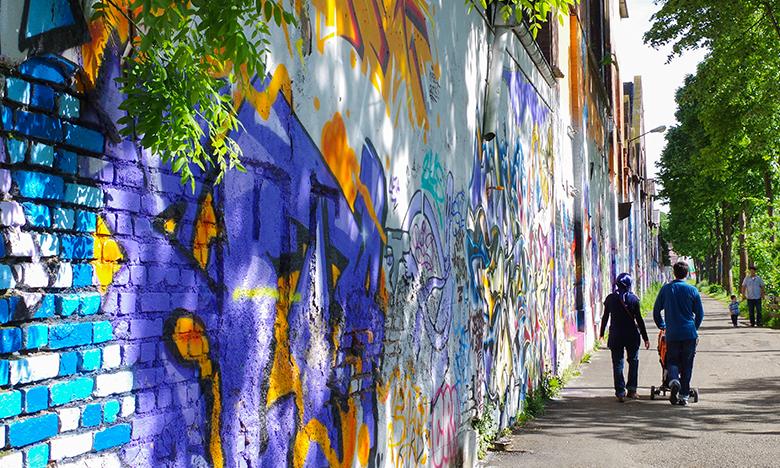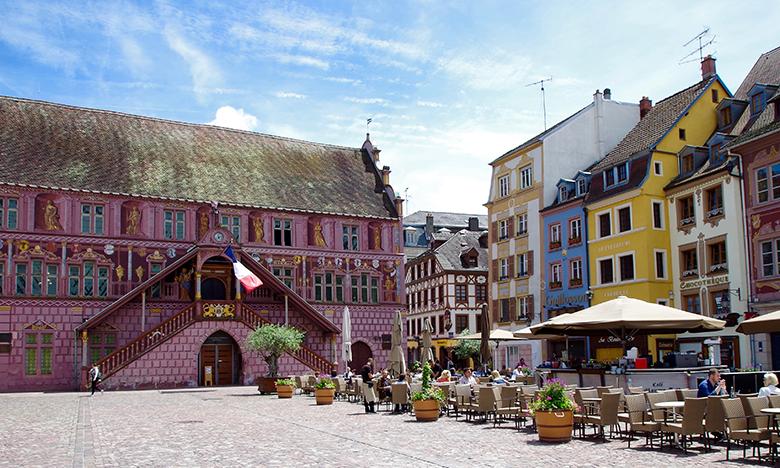For more information, visit the Tourism Office and Convention Bureau of Mulhouse at www.tourisme-mulhouse.com.
City region: Alsace / Grand Est
Population & what they are called: 112,127 inhabitants (2014 census), called Mulhousien
Access from Paris:
by road: about 5 hours (296 miles) via the A5 autoroute de l'Est
by train: about 2 hours 40 by TGV from the Gare de Lyon
Famous native daughters & sons:
William Wyler, movie director
François Florent, actor, founder of the Cours Florent
Vitaa, singer
Most distinctive and/or unique fact or trait (or little known fact):
The world’s biggest car collection open to the public is in Mulhouse, hosted in the Cité de l'Automobile, Musée national de l'automobile, Collection Schlumpf.
Given its industrial underpinnings, Mulhouse has been nicknamed "the French Manchester" or the "city with a hundred chimneys.”
Notable sites:
Parc zoologique et botanique – a “remarkable garden” and zoo specialized in preserving endangered animal species and celebrating its 150 anniversary in 2018 (zoo-mulhouse.com)
Temple Saint-Etienne – the only protestant church on a main square in France and the tallest protestant building in France
Ancien Hôtel de Ville – the 16th-century town hall which contains a history museum
Top annual events:
Scènes de rues – a four-day street theater festival (scenesderue.fr)
Etofféeries (Marché de Noël) – every year, the Christmas Market and city center are dressed in a new fabric created by a local designer – this year, blue and gold colors by Acanthus Festis (etoffeeries.fr)
Carnaval de Mulhouse – a buzzing atmosphere, carnival groups’ “Guggamusik” and good times guaranteed for thousands of carnival-goers (carnaval-mulhouse.com)
Most notable museums:
Cité du Train / Cité de l'Automobile – respectively the largest railway and automobile museums in Europe (for trains) and the world (for automobiles) (citedutrain.com / citedelautomobile.com)
Musée de l'impression sur étoffes – a museum of printed textiles that bears witness to the textile heritage (musee-impression.com)
Ecomusée d'Alsace – lively open-air museum of over 70 traditional houses and seasonal programming (ecomusee-alsace.fr)
Culinary specialties:
sauerkraut – emblematic meal of pickled cabbage, sausages, smoked bacon and potatoes, best eaten in a winstub (local restaurant)
fleischschnakas – a salted log cake (pastry and meat) shaped like a snail (“schnaka” in the local language)
bredala – without these biscuits Christmas wouldn’t be Christmas in Alsace
Local wines & spirits:
Alsace wines – the famous Alsace Wine Route is 25km from Mulhouse and leads through medieval villages where wines are tasted directly at the growers (route-des-vins-alsace.com)
schnapps – Alsatian brandy made with local wine, flowers, herbs and fruits such as the plum-like damson
beer – lots of local craft beers mades by micro-breweries
Shopping:
La Vitrine – a temple to local and Alsatian creativity (danslavitrine.com)
La Maison Alsacienne de Biscuiterie – special artisanal confections (maison-alsacienne-biscuiterie.com)
Most popular night spots:
Le Gambrinus – a beer bar and restaurant with evening programming that usually involves music
Noumatrouff – the local alternative scene for the music of today
La Quille – a highly esteemed wine bar
Local population’s favorite activities (or hangouts):
Quai des Pêcheurs – to enjoy the latest street-artists’ performances along the edge of the river Ill
Historic Mulhouse – the medieval lower town, the Rebberg district and around the Place de la Bourse in the Nouveau Quartier
Parc Wallach – a “remarkable garden” for a walk in the rose garden or run in the nearby Waldeck Forest
Local industries:
automobile – PSA Mulhouse, the Peugeot factory in Mulhouse, is the largest employer in Alsace (museepeugeot.com/en/aventure-peugeot-museum/car-factory-visit.html)
textiles – Dollfus-Mieg et Compagnie (DMC), is the world leader in embroidery and crochet yarn with 40,000 retail outlets all over the world
In Pop Culture:
- Parc du Petit Prince – more than 30 experiences in Little Prince Parc make it the first “aerial park” in the world (parcdupetitprince.com)
About Top French Cities - www.francepresskit.com
Top French Cities is an association of 29 cities, from regional capitals like Bordeaux to important towns like Avignon and Versailles. They are perfect for young travelers, families and anyone else looking for fun and authentic French experiences that will fit their budget. Most of these cities are university towns with a youthful atmosphere, but all of them reflect the heritage and distinctive flavors of the regions to which they belong. Many are forward-looking too, with historic buildings repurposed to house contemporary art and activity centers like Les Docks in Marseille. Many have created or integrated new, modern museums to contrast with their classical, architectural heritage, like in Nimes, where the cutting-edge Museum of Roman Civilization (Musée de la Romanité) is located across from the historic Roman amphitheater, or in Nantes, where whimsical mechanical creatures are being created, or in the UNESCO World Heritage Site concrete city of Le Havre.



